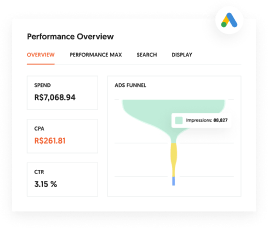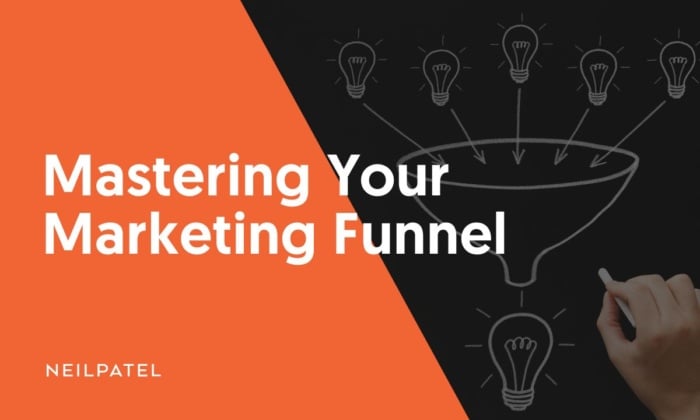
If you’ve spent any time learning about marketing analytics, you’ve probably come across the term “funnels.” What is a marketing funnel, and why do they matter?
Marketing funnels are a useful tool to help you visualize the path customers take from first finding out about your brand to converting. Understanding them provides valuable insight into why some customers convert — and some don’t.
Understanding how — and when — consumers interact with your brand is crucial. It makes it easier to target them, provide them with the information they need, and move them closer to a purchase.
Once you know where you’re losing customers, you can adapt your strategy to enhance conversion rates.
Sound good? Then let’s delve deeper.
What Are Marketing Funnels?
A marketing funnel is a visual representation of the steps a visitor takes from first finding out about your brand until they convert. The most common type of marketing funnel consists of four stages known as AIDA:
1. Attention: A prospective customer sees your ad or social media post or hears about you from a friend.
2. Interest: They think you can solve a problem and want to learn more.
3. Desire: The prospect has done their research and wants to convert.
4. Action: The prospect takes action — they buy your item, schedule a demo, or take whatever other action you want them to take.
The action can vary based on the customer and industry — maybe you want them to make a purchase, sign up, or fill out a form. When someone does something you want them to do, it’s known as a conversion. The visitor converts from browsing to taking the action you want them to take.
Think about Amazon’s marketing funnels. There are several steps a visitor has to go through before they can purchase a product. Here’s how it looks, they:
- Visit Amazon.com
- View a product
- Decide to add a product to the cart
- Complete the purchase
There are additional steps/actions that shoppers can take, but they don’t matter in marketing funnels unless they contribute to the final action. For example, a visitor may view Amazon’s Careers page, but we don’t need to count these in the funnel because they aren’t necessary steps.
Why is the set of steps to conversion called a “funnel”? Because at the beginning of the process, there are a lot of people who take the first step.
As the people continue along and take the next steps, some of them drop out, and the size of the crowd thins or narrows. As a result, only some people in the funnel convert. Just the most interested buyers move further down.
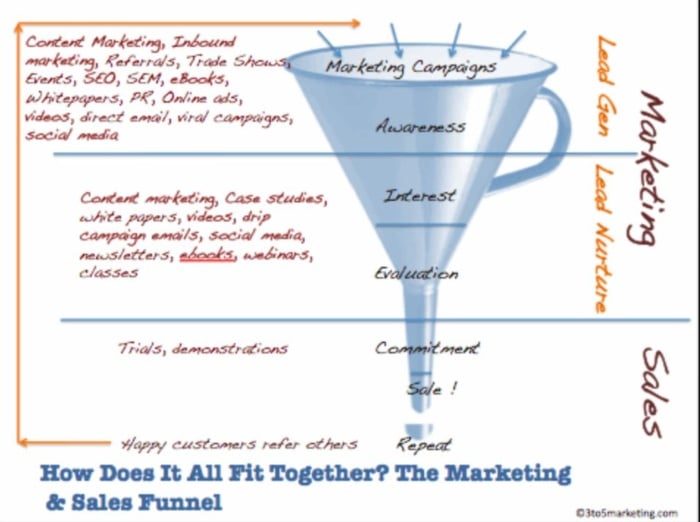
Perhaps you’ve heard the phrase “widening the funnel?”
This refers to casting a larger net by advertising to new audiences, increasing brand awareness, or using inbound marketing to drive more people to the site. The more people in the funnel, the wider it is.
What Are the Different Types of Funnels?
All marketing funnels start with some sort of advertising. That might be a PPC ad, content marketing campaign, white paper download, video ad, social media ad, or even an IRL ad.
Types of funnels you might hear about include:
- Sales funnels
- Webinar funnels
- Email funnels
- Video marketing funnels
- Lead magnet funnels
- Home page funnels
Despite the different names, these all track the same thing — the steps a prospective customer takes to conversion.
What Can You Use a Marketing Funnel For?
Aside from attracting sign-ups and purchases, marketing funnels have many other purposes. You can put funnels all over your website to see how visitors move through a specific website flow.
You may want to track newsletter signups. (Viewing newsletter signup form > Submitting form > Confirming email) or a simple page conversion (Viewing a signup page > Submitting signup).
Figure out your goals and what you want visitors to do on your site, and you can create a funnel for it.
Once you have the data, you can see roadblocks and optimize your funnel marketing. Let’s dig a little deeper into that.
Why Are Marketing Funnels Beneficial?
Marketing funnels provide access to data, called a marketing funnel report, which lets you see where you are losing customers. This is sometimes called a “leaky” funnel because it allows customers you want to keep to escape the funnel.
Let’s take your average SaaS business as an example. Here’s how a funnel may look for them:
- Visited site
- Signed up for a trial
- Used product
- Upgraded to paying
Do people have to use the product before paying? They don’t, but it’s a good idea to track it so you can see if it’s a roadblock.
For example, if you lose numerous conversions after the trial stage, you might need to update your onboarding process so people understand how to use the tool. Alternatively, you can adjust the top of your funnel to avoid attracting people outside your target audience.
A Real-Life Marketing Funnel Example
Let’s take a look at an e-commerce purchase funnel.
The e-commerce store has a bird’s eye view of what is happening within the funnel because it tracks conversions like this:
- Buyer adds an item to cart
- Buyer proceeds to billing and shipping
- Buyer completes payment
- Buyer proceeds to purchase completed process
Their marketing funnel would look something like this example from Smartlook:

Okay, now we understand what a funnel is and why it helps. Next, let’s look at Google Analytics.
How Google Analytics Marketing Funnels Work
Google Analytics offers marketing funnels. They’re possibly one of the simplest ways to track prospects’ paths before they convert. Simply sign in, then head to Admin > Goals > +New Goal > Choose a Goal to create a Google Analytics goal. You can learn more about the different types of Goals you can make in Google’s documentation.
Easy, right?
However, here are a couple of things to consider when creating funnels in Google Analytics:
- It’s a pretty basic funnel: If you don’t want to dive deep into the data and optimize, you can go with this.
- You cannot go back and retroactively view data: Once you create your funnel, you can only see the funnel going forward as fresh data comes in.
Overall, if you are new to marketing funnels, Google Analytics funnels is a solid place to start.
How to Create a Marketing Funnel
You can use several models to create successful marketing funnels that convert. Let’s discuss some techniques you can use in your funnel marketing efforts, starting with the ideal buyer journey.
1. Determine Your Ideal Buyer Journey and Map It Out as a Funnel
A conversion funnel aims to build an effective buyer’s journey and increase your conversions. However, you must first identify your starting point and end goal to do this. In other words, you must determine three things:
- What your typical buyer’s journey looks like right now
- What your end goal is, or what action you want a prospect to take
- How you can improve your existing buyer’s journey to increase the likelihood of leads becoming paying customers
Once you’ve identified your end goal, you can map it out as a marketing funnel. Visualizing or mapping out your funnel can help you stay on track further down the line.
2. Set Goals for Each Stage in Your Funnel
It helps to think of your marketing funnels in three parts: the top, middle, and bottom. This visual from WordStream shows how your goals differ at each stage.
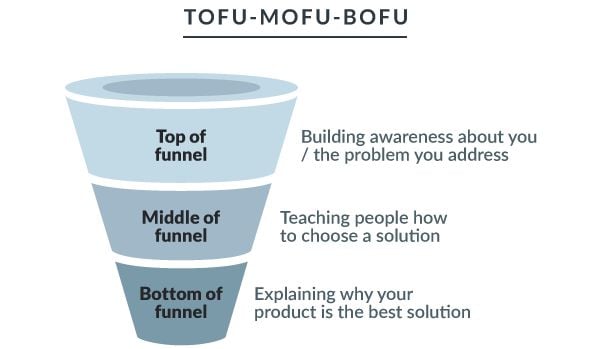
Decide what you want from each stage of the funnel. For example, you might want to increase your traffic at the top of the funnel, boost your engagement rate in the middle, and improve your conversions at the end.
Once you’ve set concrete goals, consider using tools to track your progress and ensure you meet those objectives. For instance, you could use Google Analytics or email automation software to measure your success rates.
3. Make a Content Plan for Each Stage in the Funnel
Each part of the funnel (top, middle, bottom) requires its own marketing plan to keep prospects moving from one stage to the next.
Let’s break this down.
- Top: Build brand and product awareness. Use visually engaging content such as videos, short blog posts, and social media posts to introduce your company and emphasize your brand story.
- Middle: Gain trust and demonstrate how you can meet your customers’ needs. A prospect could be in this stage for a while, so the focus should be on creating valuable, informative, and reliable content such as case studies, video tutorials, and downloads.
- Bottom: Give prospects a reason to buy, sign up, or take action. Marketing strategies at this stage could include free trials, actionable emails, CTAs, or calls to action.
4. Implement Strategies and Create Content to Generate Awareness
You’re trying to build hype around your brand and product at the first stage in your marketing funnel. Why should a customer care about your company? How do your products solve the problems they have? Answer these questions to help build a content strategy for this phase.
Do some competitor research, too. Consider what you can learn from their landing pages, social media channels, and blogs. How are they reeling in potential customers?
Use tools like Ubersuggest to discover your main competitors. Analyze their landing pages and blog content to find elements that you can replicate or improve upon.
Monitor their social media channels with social listening tools. Ensure you check the type of content they are posting, the engagement they are receiving, and their overall social media strategy. Use what you find to inspire your own strategy.
You can also use tools like Buzzsumo to discover viral content and analyze popular articles. What makes them buzz-worthy? Try and emulate them.
You’ve got a content plan, but it’s not much good on its own. You need to know how to attract and create desire.
5. Generate Interest and Desire
While the AIDA model labels “interest” and “desire” as two different outcomes, they’re the same thing in real terms.
Generating interest, or building desire, comes down to one key thing — creating compelling content. Your content should:
- Build some awareness around your brand
- Show people why they “need” what you’re selling
- Get consumers to decide they “want” your product.
How do you create great content to nudge people along this stage of your funnel? Here are some ideas.
- Provide Valuable Content: Craft authoritative blog posts to educate your audience. If users find your content valuable, they’re more likely to trust you enough to spend money on your products.
- Use Video: Show your product in action by creating a YouTube video. Video content helps people visualize how the product could benefit them, making them feel like they “need” the item.
- Send Curated Emails: If you have a prospect’s contact details, send them curated email content such as roundups of your top blog posts, customer testimonials, or other tips that could benefit your reader.
- Share Customer Success Stories: Sharing success stories from happy customers is a great way to show the benefits of your product and how it can help others achieve their goals.
- Use Comparison Content: Differentiate yourself by comparing your offering to similar ones in the market. Highlight the unique benefits to show why it’s the best choice for potential customers.
- Use Expert Content: Establish your authority in the industry by providing expert content such as research reports, case studies, or whitepapers. This showcases the value of your product or service to potential customers and helps them understand how it can benefit them.
There are other ways you can generate interest, too, such as starting a podcast, creating product guides, running a free trial program, or offering product samples.
6. Encourage Users to Take Action
At the end of the marketing funnel, your goal is to convert a lead into a customer by encouraging the necessary action. Your desired action may differ according to your business strategy. Here are some examples of actions you may want your prospects to take.
Create a PDF Download
Put some valuable content in a PDF download and offer it in exchange for a prospect’s contact details. Ensure your document promises to answer common customer questions to encourage them to download it.
Here’s an example from LegalSuite, a legal services provider. Their customers typically want help with streamlining their operational efficiency. To help their customers, LegalSuite offers a free eBook with ways to make their legal operations run more efficiently.
The catch? Prospects must provide some contact details, which means that LegalSuite can follow up with them:
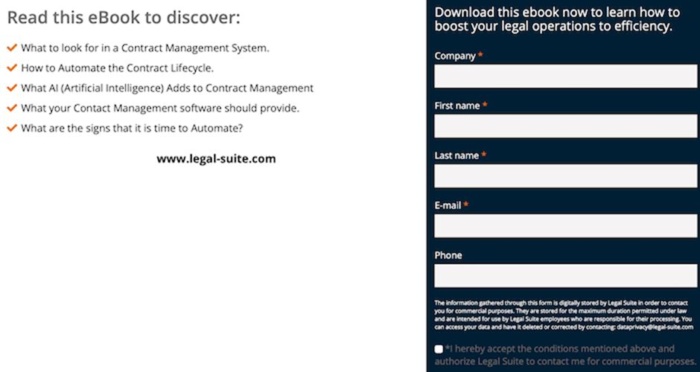
This is an excellent example of encouraging action without being pushy.
Add a Call to Action (CTA) to Relevant Resources
CTAs clarify the action you want people to take, so don’t forget to add them to your content. Here’s a great example from jewelry retailer Pura Vida bracelets.
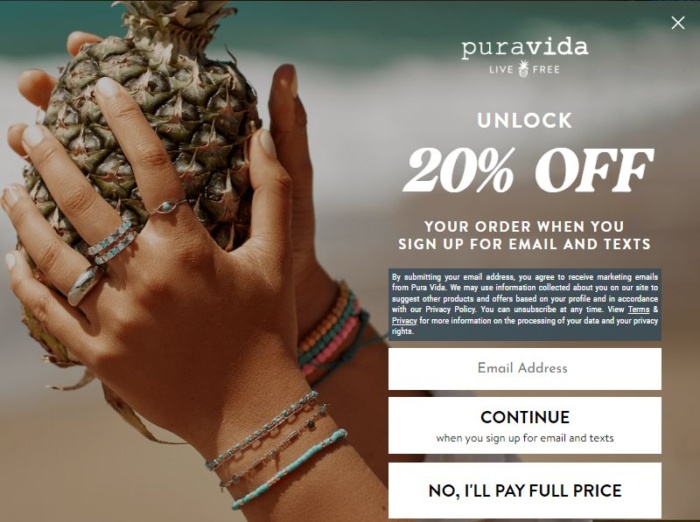
At this marketing funnel stage, you’re trying to entice customers to take a final step to complete the cycle. Therefore, give your CTAs a sense of urgency. Emphasize how your product can solve their problem and why they should act now.
Make it easy for customers to act by displaying the CTA somewhere prominent, like the top of a landing page, the end of a guidepost, or a colorful, clickable button at a strategic point in a YouTube video.
Finally, test your CTAs to identify which strategy resonates most with your audience.
Send Actionable Emails
In many ways, great marketing is all about helping people help themselves.
Send them clear, concise, actionable emails emphasizing how they can solve their problems by buying your products or using your services.
Again, ensure there’s an obvious CTA so potential customers know what action you expect them to take.
If you’re looking for a starting point, Tutsplus.com has some free email newsletter templates.
Incorporate Customer Testimonials
Did you know that 72 percent of customers won’t purchase until they’ve read some reviews? Give those customers the reassurance they need to take the final step by adding testimonials to your page.
You can either ask customers for reviews or look at your existing reviews on websites like Facebook and LinkedIn and ask permission to share them in your content.
Where should you display testimonials?
It all depends on your audience, brand goals, and marketing strategy. You could, for example:
- Include some quotes from positive reviews on your landing page
- Embed a widget from a website like Trustpilot on your page so prospects can read your reviews before they buy
- Link to videos of happy customers using your products (remember to thank them for trying out your product, too!)
- Add testimonials to your product/services pages
- Use testimonials on landing pages to persuade visitors to take a specific action, such as signing up for a free trial or subscribing to a newsletter
- Share customer testimonials on your social media channels to showcase the positive experiences your customers have had with your brand
Eyewear brand Warby Parker groups their customer testimonials by topic on a specific reviews page.
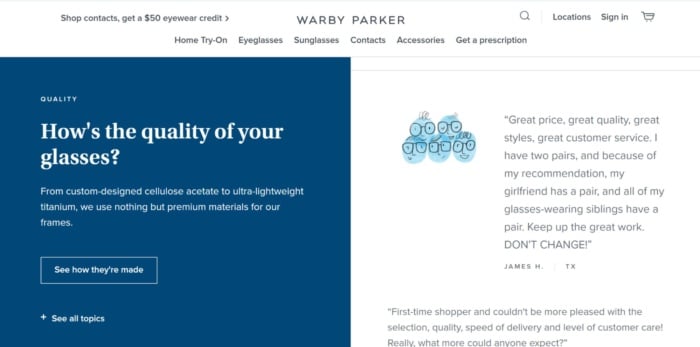
Other Ideas
Finally, offer other incentives like free trials, competitor comparison guides, demo videos, and product samples to nurture leads into becoming paying customers.
7. Keep Customers
Great marketing is about more than finding customers. It’s about retaining them, too. Acquiring new customers can cost up to five times more than retaining existing ones so retention is a skill you must master.
In addition to the cost benefits, did you know your existing customers are roughly 50% more likely to try your new products? Armed with this knowledge, you have the potential to experiment with different approaches at the top of your retention funnel. For example, you could remind loyal customers of the value of your product or provide updates about exciting new developments.
Sounds great, right? Here are some strategies for retaining those all-important loyal customers.
- Next-sell: This is when you follow up with a customer after purchase and offer them a similar product with, perhaps, an attractive discount attached. This allows you to communicate with your customer and make them feel valued, and it’s a way to potentially increase revenue.
- Create Loyalty Programs: Loyalty programs are crucial to any customer retention strategy, with 81 percent of millennials spending more money when they’re a loyalty scheme member. However, since loyalty schemes are nothing new, you need to get creative.
- Product Updates: When you update your products, you’re keeping up with evolving customer demands and changing expectations; you’re showing your loyal customers that you value their continued loyalty.
Other techniques include Introducing member-only events, sending out exclusive emails, running contests or prize draws, and starting a customer service RSS feed.
8. Grow Customers
Finally, don’t forget to capitalize on your existing customers by encouraging them to purchase more. You could try a few strategies to incorporate into a growth marketing funnel. Here’s an example of what that might look like:
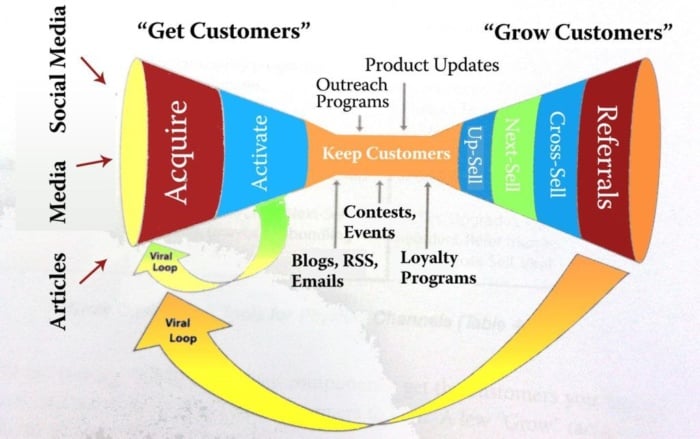
Let’s take a closer look at how you can grow customers:
- Cross-selling: Look at a customer’s most recent purchase and show them similar products they might be interested in. Or, during the sales process, offer them other items that complement their purchase.
- Upselling: Offer customers a more expensive alternative to the item or service they’re interested in. When you’re upselling, comparing products or services side-by-side is helpful. However, don’t try to upsell a product if it’s substantially more expensive than the potential customer wants and avoid being too pushy. Otherwise, the strategy could backfire!
Here’s a good example of upselling from Best Buy. The customer views a MacBook Air selling at $999.99. Below the product, they see other products from the MacBook range. The first option is more expensive but also has an enticing discount attached to it:
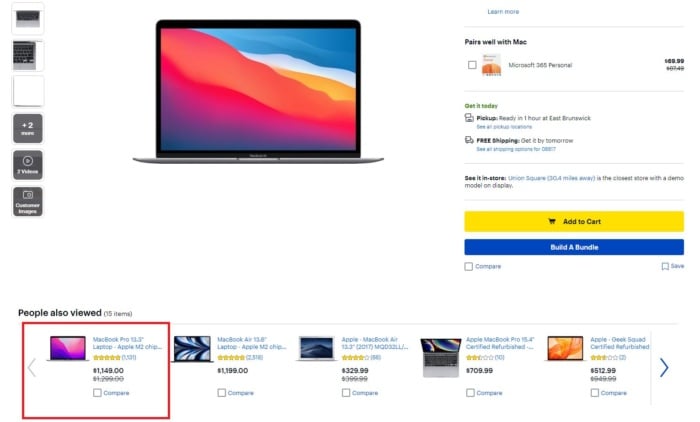
The products advertised aren’t massively different in price from the viewed product, and it’s a good, subtle example of upselling.
There are a few other strategies you can try to grow your customer base and build your business, including:
- Sending out discounts to loyal customers
- Personalizing your marketing emails
- Issuing more voucher codes
Test out a few options and identify which resonates best with your customers.
Optimizing Your Marketing Funnel
In reality, there’s no such thing as a perfect marketing funnel. However, if your marketing funnels are underperforming, it could be due to common errors such as:
- Leaving out a strong CTA
- Forgetting to start with a clear brand message
- Using too many steps in your funnel
- Misreading your funnel analytics data
- Failing to follow up with leads
- Weak offers that don’t resonate with prospects
- Lack of personalization, making engagement difficult
Consider the following ways to audit and optimize your marketing funnel.
Analyze Your Landing Page and Sign-Up Forms
Take a look at your landing page and test the following elements:
- Headlines: Test different headlines to see which ones attract and keep the most visitors.
- Copy: The copy should be full of benefits to the reader, leading off with the most promising. Check out this post for tips on writing copy that converts.
- Color: Test different background and text color to improve conversion.
- Font Style and Size: Try different font sizes to see which size keeps readers on the page longer. Also test different font styles to see how they impact conversion.
- Purchase Path: Test the path to purchase to eliminate any friction you uncover. Tip: lowering the page loading speed may be your biggest culprit when it comes to abandonment rates. Use Google’s PageSpeed Insight tool to test your conversion funnel. You can also uncover the impact slow page load has on conversion during a usability test. Use both in combination to get the optimal purchase path.
Test Your Trust Elements
Trust on the web is huge — especially when getting people to give you their money. This is why you must build trust in your landing page and throughout your online marketing funnels.
At a minimum, you need these elements:
- Guarantee: Will you give them their money back if they are unsatisfied? Will you do this in 30 days? 60 days? 90 days? Test different variations to see which pulls the best.
- Better Business Bureau Logo: Applying for a BBB logo for your site is pretty straightforward. You have to be a local chapter member and pay around $400/year— a small price to pay for the benefit of putting your customers at ease.
- VeriSign Logo: The VeriSign logo is an internationally-recognized symbol that your online check-out process is safe and secure. That’s huge. Try to do business without that seal, and your online conversion rates will plummet. You can get a VeriSign seal for less than $300 a year.
Reviews and using HTTPS can also boost trust.
Use all three trust elements above for best results, but that doesn’t mean you shouldn’t do a few rounds of A/B testing, experimenting to find out which logo is the most effective. You’ll especially want to find out the best position of each trust element on the page.
The Morgan & Morgan law firm uses trust symbols, and customer reviews well.
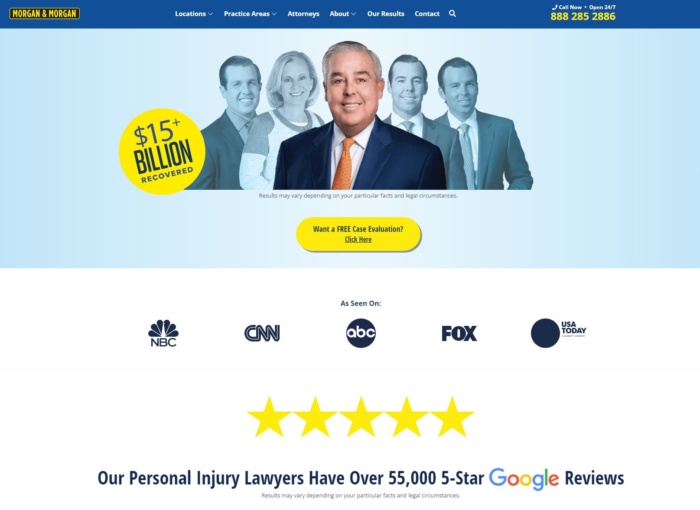
Their footer also includes relevant trust symbols:

If you’d like to learn more about building customer trust, read my article 10 Ways to “Guarantee” More Sales and Conversions for more information and examples.
Test Your Email Conversion
Building an email newsletter list is essential to your online conversion funnel. Test these elements in your emails:
- Open Rates: Your email newsletter lives or dies based on your subject lines. Make sure you are using the most compelling copy. Test different variations constantly to raise conversion rates.
- Copy: Test short or long copy in the email, preferably finding out if the bulk of your audience wants to click through and read everything on your site.
- Click-Throughs: Open rates alone won’t tell you the whole story. Embed links throughout the copy to see if more or fewer links drive people to click. And test different anchor text copies.
- Plain Text vs. HTML: Find out if your audience prefers email in plain text or HTML-based. A great way to find out is to use a simple survey.
- CTA: Test different calls to action to see which drives more traffic to your site. Also, test the position of these CTAs on the page.
Let’s shift gears now and discuss how to test these different conversion funnel elements.
Combine Usability and A/B Test Results
Talk to most people about metrics, and they’ll either talk about user testing or A/B testing, but rarely both. That’s unfortunate because they work together perfectly.
Here’s how:
- Get qualitative feedback from users during a usability test: Your first step should be a usability test. This user test can be casual but tightly focused. Just have them focus on the page where conversions matter the most (sign-up form). You would be surprised how much insight you can get from feedback from a very small group.
- Analyze your user testing results: This feedback should help guide your design of the page. You should walk away with three or more design alternatives.
- Run your A/B testing: Once you have those alternatives and insights from user testing, start your A/B testing. Your A/B testing should help you narrow your choices between design alternatives and on-page elements, eventually landing on the most optimized page performance.
In the end, A/B testing confirms your usability test insights, giving you more effective results than if either were used alone.
If you’re new to usability testing, here are some resources to check out:
- Usability 101: Introduction to Usability: By Jakob Neilson, the godfather of usability.
- Usertesting.com: Get a video of a user talking about your site as they work through it and a written summary of problems they encountered.
If you’re new to A/B testing, check out our A/B testing guide.
Run A Mom Test
Okay, so it doesn’t have to be your mom, but make sure it isn’t one of your internet-savvy friends. In other words, it should be a regular web user because you want to see how most people navigate your marketing funnel.
Call this person and ask them to find your site on Google and complete the conversion process. Make sure you tell them what you expect users to do.
Stay on the phone and ask them to talk out loud as they do their search. Record the phone call and take notes until they are finished.
Make tweaks to your conversion process and repeat the funnel optimization process until people can work through the process without abandoning the process.
Run an Online 5-Second Marketing Funnel Optimization Test
Finally, you must keep things simple when creating a well-built conversion funnel; be sure to eliminate all distractions.
I’ve found that by running a simple visual presentation, you can learn a lot about the simplicity of your marketing funnels.
This is where the five-second test comes in.
In marketing, the five-second rule refers to the idea that visitors to a website or consumers of a marketing message make a quick decision about whether to engage with the content or move on within the first five seconds.
It centers on the notion that people have limited attention spans and are constantly bombarded with information, so marketers must quickly capture their interest and attention. Uxtweak provides a great how-to:
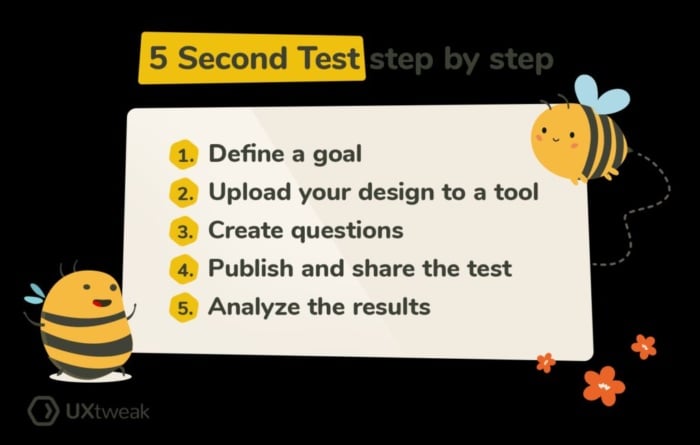
You can choose from several tools, including:
- UXtweak Five-Second Test
- UsabilityHub’s Five-Second Test
- Optimal Workshop’s First Click Test
- Maze Five-Second Test
FAQs
The four stages are “Attention,” “Interest,” “Desire,” and “Action.” You’re trying to attract attention, generate interest, encourage customers to want the product and have them take the desired action.
The goal is the objective you’re trying to achieve, e.g., a customer completing a sale. The funnel is the journey the prospect takes to reach this goal.
Start by checking out funnel visualization tools like Google Analytics.
A marketing funnel shows the paths people take from visiting your website to becoming paying customers.
A marketing funnel, or a sales funnel, refers to the process a customer goes through to become aware of, evaluate, and eventually purchase a product or service.
A brand funnel is the customer journey buyers go through until they reach brand loyalty.
Conclusion
We’ve covered just about everything you need to know about marketing funnels. You can see the role they play in building your brand and why they are essential to your promotional efforts.
As detailed in this article, a marketing funnel can take many forms, including sales, video, and landing page funnels.
Marketing funnels give you vital access to understand drop-off points during the customer journey, allowing you to address any issues along the way.
A marketing funnel can help you grow your audience and increase conversions when correctly implemented.
Do you use marketing funnels? Which is your preferred model and why?

See How My Agency Can Drive More Traffic to Your Website
- SEO - unlock more SEO traffic. See real results.
- Content Marketing - our team creates epic content that will get shared, get links, and attract traffic.
- Paid Media - effective paid strategies with clear ROI.
Are You Using Google Ads? Try Our FREE Ads Grader!
Stop wasting money and unlock the hidden potential of your advertising.
- Discover the power of intentional advertising.
- Reach your ideal target audience.
- Maximize ad spend efficiency.

